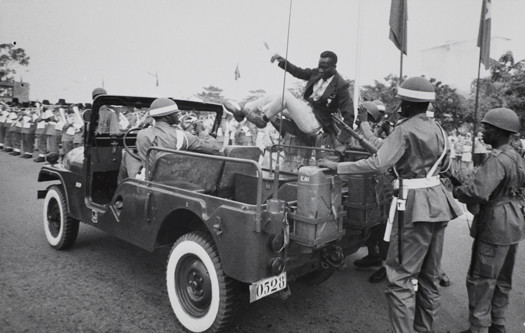Africa, there and back
25 Aug - 21 Oct 2012
AFRICA, THERE AND BACK
Photographic Collection
25 August - 21 October 2012
Images from the Photographic Collection between the colonial era and global capitalism
Under the title “Africa, there and back”, the Fotografische Sammlung at Museum Folkwang is presenting works from its collection by Wolfgang Weber, Germaine Krull, Robert Lebeck, Rolf Gillhausen, Malick Sidibé and Pieter Hugo. The exhibition focuses on the treatment of the political and cultural balance of power in the photographic medium. The timeframe spans some 80 years and stretches from the colonial era to today’s global capitalism.
Chronologically, the exhibition begins with Wolfgang Weber, who from the mid-1920s onwards provided the readers of illustrated newspapers in Germany with adventurous reports on Africa. Reflecting the prevailing colonial policy, they are characterized by the availability of space and superiority.
With the objective of demonstrating the military relevance of the French colonies, the avant-garde photographer Germaine Krull took photos during World War II for the propaganda service of the exiled French Résistance in what was then French Equatorial Africa. The motif of an area lacking rule and government that Krull effectively presented in this context can be found some 70 years later in the works of the young South African photographer Pieter Hugo, in which he outlines the consequences of global power structures as a permanent error, using as an example the high-tech recycling sector in present-day Ghana.
Photographers Robert Lebeck and Rolf Gillhausen are interested in the ambivalence between political independence and continuing dependence during decolonization. Working for German magazines such as Kristall or Stern around 1960, they accompany this phase of radical global political change in various African countries.
During the first decade after independence, photographer Malick Sidibé, who comes from and lives in Mali, chronicled the euphoric mood in his home country and produced portraits of the confident youth of Bamako.
The exhibition will be accompanied by a catalogue published by Edition Folkwang/Steidl.
Photographic Collection
25 August - 21 October 2012
Images from the Photographic Collection between the colonial era and global capitalism
Under the title “Africa, there and back”, the Fotografische Sammlung at Museum Folkwang is presenting works from its collection by Wolfgang Weber, Germaine Krull, Robert Lebeck, Rolf Gillhausen, Malick Sidibé and Pieter Hugo. The exhibition focuses on the treatment of the political and cultural balance of power in the photographic medium. The timeframe spans some 80 years and stretches from the colonial era to today’s global capitalism.
Chronologically, the exhibition begins with Wolfgang Weber, who from the mid-1920s onwards provided the readers of illustrated newspapers in Germany with adventurous reports on Africa. Reflecting the prevailing colonial policy, they are characterized by the availability of space and superiority.
With the objective of demonstrating the military relevance of the French colonies, the avant-garde photographer Germaine Krull took photos during World War II for the propaganda service of the exiled French Résistance in what was then French Equatorial Africa. The motif of an area lacking rule and government that Krull effectively presented in this context can be found some 70 years later in the works of the young South African photographer Pieter Hugo, in which he outlines the consequences of global power structures as a permanent error, using as an example the high-tech recycling sector in present-day Ghana.
Photographers Robert Lebeck and Rolf Gillhausen are interested in the ambivalence between political independence and continuing dependence during decolonization. Working for German magazines such as Kristall or Stern around 1960, they accompany this phase of radical global political change in various African countries.
During the first decade after independence, photographer Malick Sidibé, who comes from and lives in Mali, chronicled the euphoric mood in his home country and produced portraits of the confident youth of Bamako.
The exhibition will be accompanied by a catalogue published by Edition Folkwang/Steidl.

